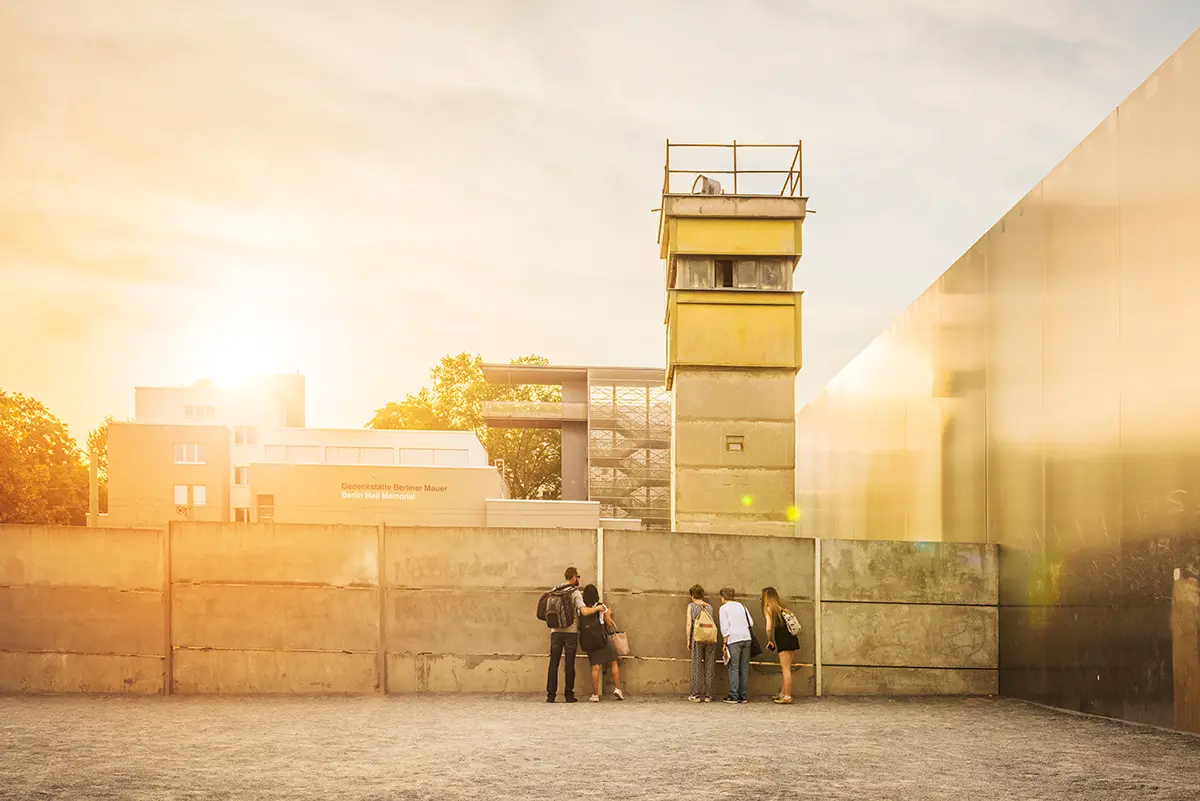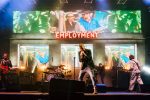Berlin, Germany – Travel Review

By Helen Johnston, June 2024
Berlin will be making history this summer when Germany hosts the Euro football championship for the first time since reunification 34 years ago, with the final to be played at the capital city’s Olympiastadion.
West Germany hosted the tournament back in 1988, a year before the Berlin Wall fell and the Soviet Union crumbled. Today, Berlin is a vibrant and cosmopolitan capital city, busy preparing to welcome an invasion of some 1.5m football fans as one of ten host cities for the Euros which kick off on June 14.
A giant goal has been erected in front of the historic Brandenburg Gate (opened in 1793 as an exit out of Berlin), and turf has been laid ready for fans to stand and watch matches on an enormous screen set within the goalposts.
“Historic”
It may still be possible for them to catch a glimpse of the bronze Quadriga statue atop the gate, pinched by Napoleon in 1806 as a war trophy then brought back in 1814 after his abdication. In the centuries since, it has witnessed many more historic occasions, perhaps most notably the gate’s reopening after the fall of the Berlin Wall.
Scenes of Berliners attacking the wall with hammers and chisels, of families and friends running to hug each other after 28 years of enforced separation, remain the most evocative portrayal of the end of the Cold War era. It’s hard to believe it’s 35 years since millions of us were glued to our TV screens watching history being made.
For this wasn’t just about Berlin, it was an historic moment shared by all Europeans and beyond. The wall’s history encapsulated far-reaching decisions made by the Allied leaders after the Second World War, which led ultimately to the so-called Iron Curtain being drawn across the divide between capitalism and communism. The British, Americans and French divided up West Berlin between them, while the Soviets controlled East Berlin.
“A city for the young”
Now though, a whole generation of adults has grown up with no recollection of the wall or a divided Germany. Apart from a few graffiti-ed remains and the artwork at the East Side Gallery stretch of the wall, the only reminder of its route is a line of cobbles and the occasional plaque embedded in the paving. It’s easy to step across the old partition without even knowing it.
Berlin’s authorities wasted no time in building on the former ‘no man’s land’ between the east and west stretches of the wall and the desolate wasteland has been transformed with modern buildings. Berlin is a city for the young and looks to the future.
As the reunified city opened up, East Berlin became a magnet for partygoers and techno music and is a popular destination for young people. The communist concrete tower blocks with their small apartments are also seen as a cool place to live. Hotel receptionist Josephine lives in one which still has a bunker and a lift which bounces when it lands on the ground floor. Her family is from the East and her mum’s diary entry on visiting the west after the wall came down includes the exclamation: “They have bananas!”
Immigrating to Germany offers a wealth of opportunities, whether for work, study, or personal growth. To make the process smoother, it’s essential to understand the steps required to relocate to a German city, from obtaining the right visa to settling into your new environment. With its strong economy and vibrant culture, Germany is an attractive destination for those looking to build a new life abroad.
Berlin tour guide Karin, a walking encyclopaedia of knowledge, gave a commentary on the city’s recent and ancient history as we pounded the pavements, hopping on and off buses and underground trains to cover as many of the must-see sights as possible. This was a 48-hour city break and every minute counted.
“Shocking reminder”
At Checkpoint Charlie, one of several control points where Westerners could enter East Berlin (if granted permission), information boards are displayed and include the heartrending photo of 18-year-old East Berliner Peter Fechter who was shot dead while trying to escape in 1962. It’s a shocking reminder of the reality of what the wall meant.
It was built by the East Germans in 1961 and it was at this checkpoint a stand-off happened in October that year, when American and Soviet tanks faced each other for more than 24 hours after a row over the free movement of US military personnel. Diplomacy saved the day, and now tourists line up to have their photos taken in front of the hut bearing the checkpoint’s name.
Berlin’s military history can’t be ignored, and the might of the Nazi regime can be seen in the enormous Detlev Rohwedder House built between 1935 and 1936 for the German Ministry of Aviation. It was the largest office building in Europe at that time but escaped being bombed by Allied aircrews during the war. Karin said one theory suggests it was because they didn’t want to hit a target connected to aviation but I’m sure it was saved more by luck than sentimentality. Its 2,800 rooms and seven kilometres of corridors are now home to the German Finance Ministry.
“Imposing example”
One building which didn’t escape the bombs was the Kaiser Wilhelm Memorial Church, its ruins now standing as testament to the damage it suffered in 1943, a reflection of the ruins of Coventry Cathedral, bombed in 1940. Both have been left untouched as a reminder of the devastation war wreaks on cities and people, and both had a modern replacement built next to them in the 1960s. What’s more, the Kaiser Wilhelm church is one of several to have received a nail cross from Coventry Cathedral, a symbol first created by a priest who found several large medieval nails in the ruins the morning after it was bombed and fashioned them into a cross.
An imposing example of Cold War architecture is the East German TV Tower which began operating in 1969, looming over the centre of Berlin with its Sputnik-inspired design. The bulbous upper part houses an observation deck from where it’s possible to see the whole city laid out before you, those tower blocks of East Berlin in clear contrast to the mixed architecture of West Berlin.
There is also a revolving restaurant which provides a continuously changing view while you eat. I was accompanied by Lina from the tourist office who encouraged me to try the local seasonal delicacy of Spargel (asparagus). This wasn’t the small and skinny green asparagus we buy in the UK; it was big, plump white asparagus which is grown undercover and only available in the Spring. It looked a bit odd but tasted good, so I was pleased I gave it a try. Lina is from Lithuania originally and grew up under communist rule but said East Berlin was more extreme, while West Berlin was extrovertly capitalist, as though both were trying to be the best (or worst?) example of their respective ideologies.
“Alternative and relaxing”
Another German delicacy I enjoyed was Flammkuchen (a bit like pizza but with a very thin dough base) with Karin at the Ständige Vertretung restaurant next to the River Spree. The name means Permanent Representation and was the title given to the East German ‘embassy’ in Bonn, capital of West Germany before reunification. The restaurant serves food typical to the Bonn region on functional wooden tables and its walls are lined with black and white photos of politicians.
The river provides an alternative and relaxing route around Berlin thanks to the many boat tours on offer, giving a different perspective on the ancient and modern buildings which line its banks. The hour-long tour with Stern und Kreis boat company took us past the Reichstag, built in 1884 and now featuring a glass dome with spiral walkway designed by British architect Norman Foster. This is free to enter but there is such a long waiting list that Karin advised booking at least six weeks in advance.
Today’s modern parliament buildings rise up from either side of the river and are currently the setting for a film and light show every night until October 3 celebrating 75 years of democracy in the Federal Republic of Germany. The first 19 articles of the German constitution are etched in glass outside the Bundestag, Germany’s parliament.
“Each to their own”
If you’re looking for a glimpse into communist life, the DDR Museum is worth a visit, although it can get very busy. It features mock-ups of rooms from those residential tower blocks, all uniformly small and functional, looking like they’re straight out of the 1970s. There are also plenty of artefacts to view, such as foodstuffs and newspapers, and photos of East Germans frolicking naked on holiday. Each to their own!
There was a suspicion that the TV Tower, planted in the centre of the city, was also used as a listening device to spy on West Berlin. It’s certainly plausible if a visit to the Deutsches Spionage Museum (Spy Museum) is anything to go by, which describes Berlin as the capital of spies. The interactive displays reveal the secrets of real-life James Bonds, with tiny cameras hidden in briefcases and handbags, machine guns secreted in violin cases, coding machines and lie detectors. There is even the first encrypted mobile phone used by former Chancellor Gerhard Schröder.
It’s not all about history and politics in Berlin though, it’s also a great city for shopping with all the high-end designer names you can think of located along the beautiful tree-lined boulevard Kurfürstendamm, or Ku’damm for short. This is the showpiece of the old West Berlin and surely a paradise for the wealthy. I stuck to window shopping.

Christmas market at the Kaiser Wilhelm Memorial Church
© visitBerlin, photo: Schaustellerverband Berlin
“Great location”
The ornate buildings along the Ku’damm include Louisa’s Place, a stylish boutique hotel where I stayed in a spacious suite which felt more like an apartment with its kitchenette, dining table and sofa, large bathroom and bedroom. There was also an enclosed balcony with colourful window boxes of red geraniums and large windows which could be opened wide to enjoy the view of the street scene below. The building dates back to 1905 and has been decorated sympathetically in keeping with its age. It became a hotel in 2003, named after Queen Louise of Prussia, and includes a swimming pool and spa for those who want to spend some time relaxing away from the bustle of the city streets.
The hotel is in a great location for getting about on the plentiful public transport. It’s a stone’s throw from a bus stop and the Adenauer Platz underground station and is a ten-minute walk from the Charlottenburg city train station. I used a Berlin WelcomeCard which provides unlimited travel on all public transport for €31 for 48 hours. Longer timespans are available.
All those football fans getting ready to descend on Berlin this month will have no problem moving freely about the city, whether they have come from north, south, east, or west. How lucky they are.
For more information about a city break to Berlin go to visitberlin.de
For details and prices at Louisa’s Place hotel visit louisas-place.de
The Berlin Welcome travel card berlin-welcomecard.de
Berlin TV Tower tv-turm.de
Stern und Kreis boat tours sternundkreis.de
DDR Museum ddr-museum.de
Deutsches Spionage Museum deutsches-spionagemuseum.de
Top image: © visitBerlin, photo: Dagmar Schwelle
















